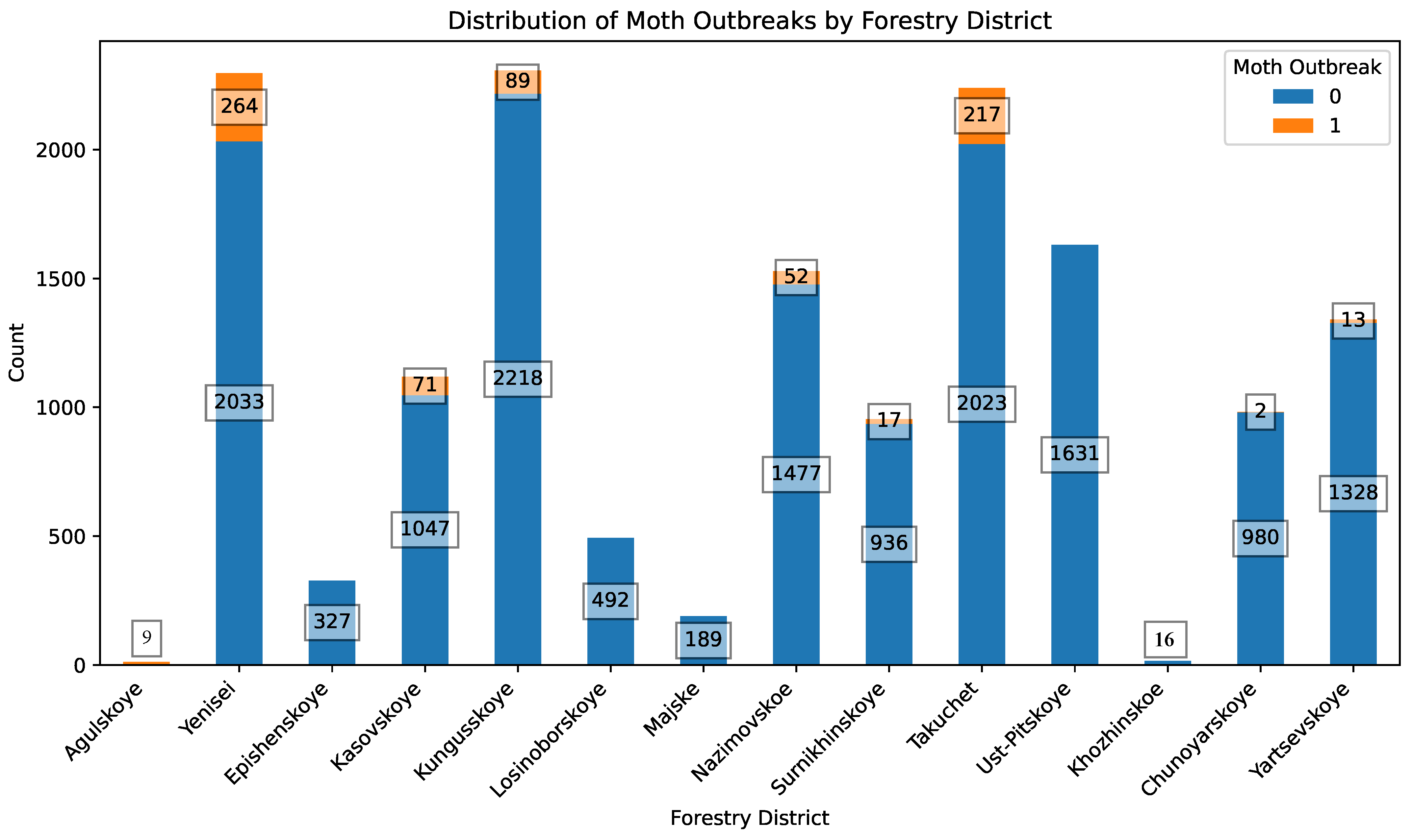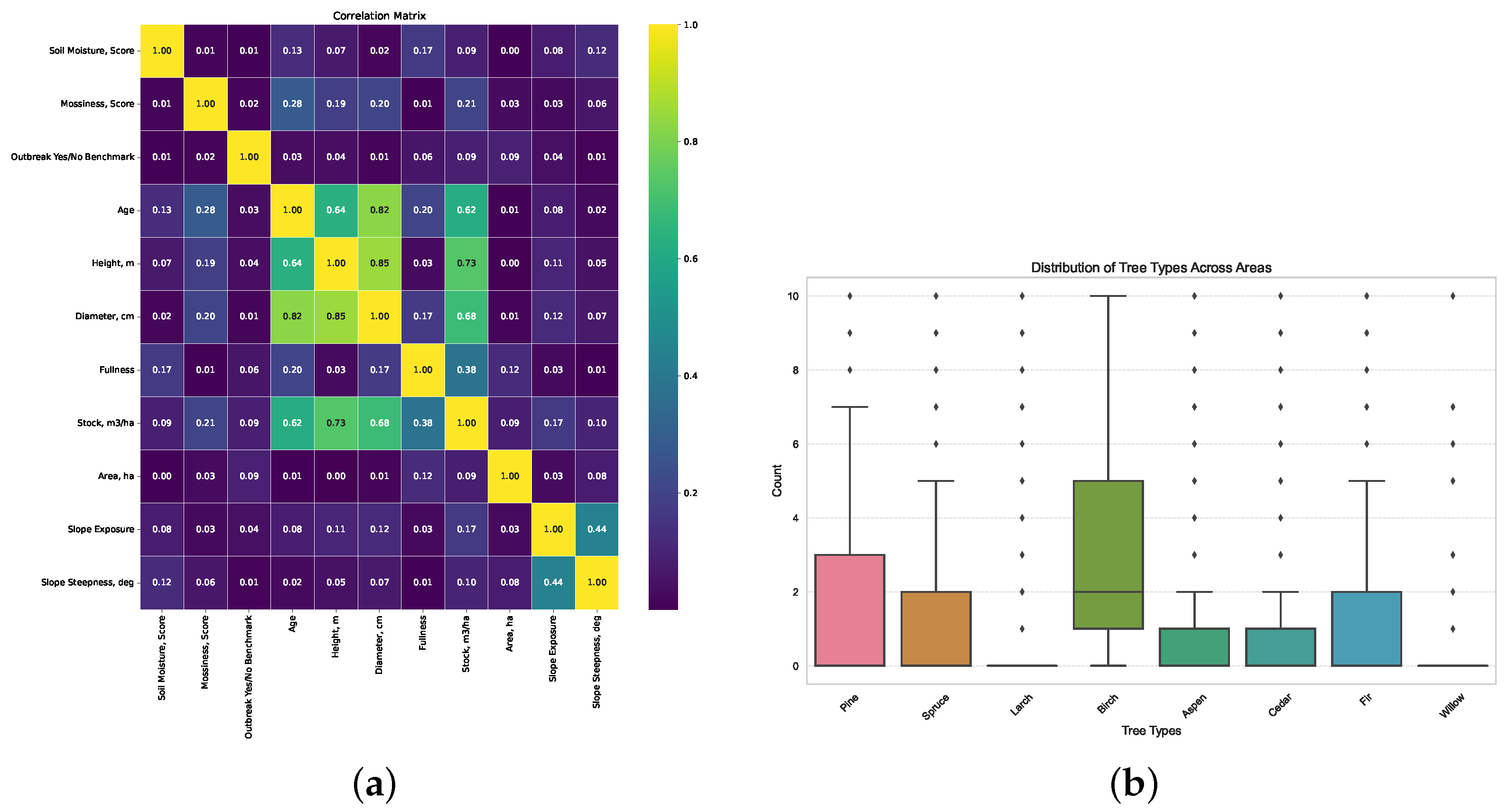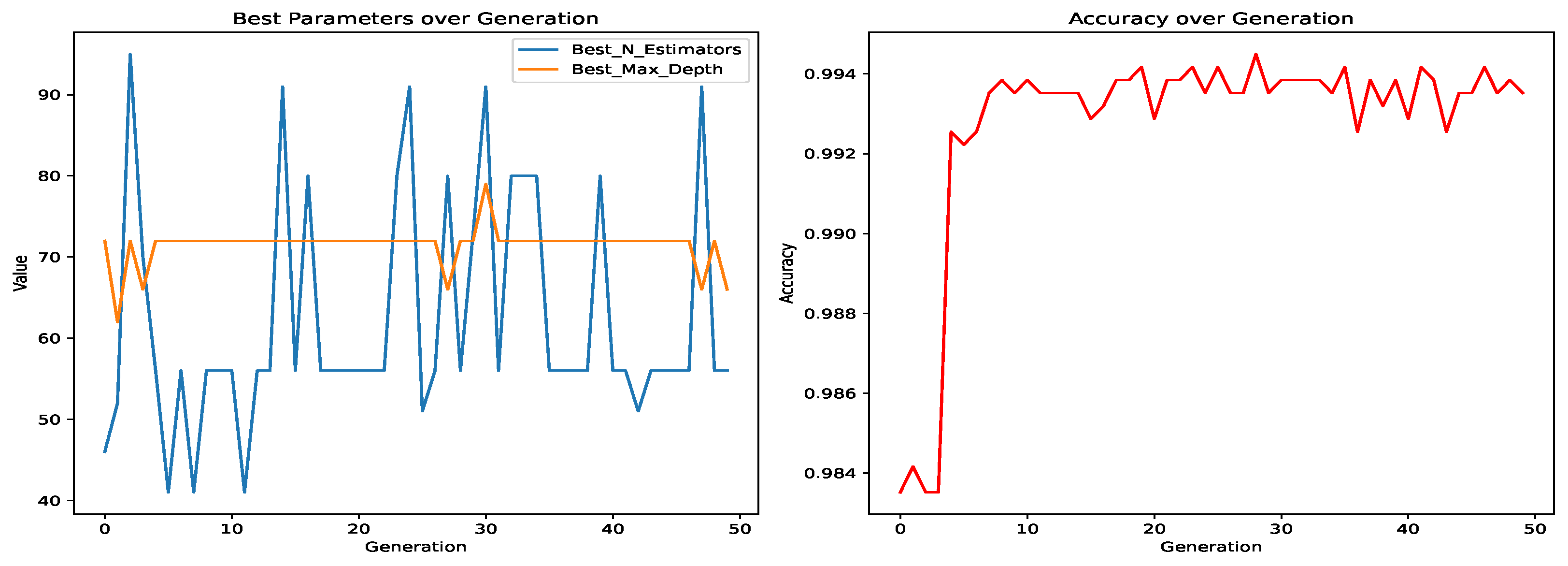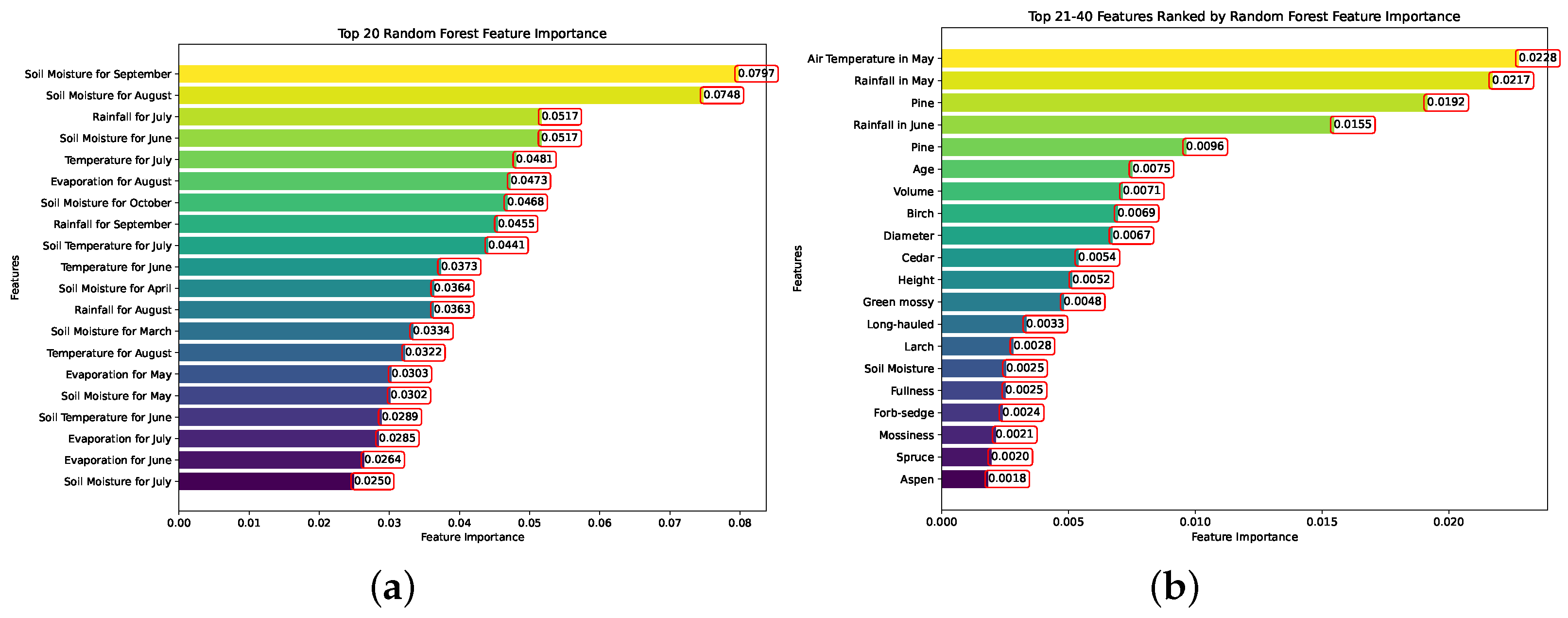Forecasting Dendrolimus sibiricus Outbreaks: Data Analysis and Genetic Programming-Based Predictive Modeling
Abstract
1. Introduction
- Our primary goal is to identify the optimal parameters for a classification model, employing machine learning techniques rooted in genetic programming.
- Specifically, we aim to forecast Siberian silk moth outbreaks one year in advance.
- The identification of these parameters is essential for precisely distinguishing between infected and uninfected forest plots.
2. Materials and Methods
2.1. Data Collection Methods and Analysis
2.2. Application of Machine Learning Technique
3. Results
4. Discussion
5. Conclusions
- Integration of Additional Variables: Explore the inclusion of supplementary environmental variables beyond those considered in the current model, such as soil properties [49] (e.g., pH, nutrient levels) and landscape characteristics [50] (e.g., topography, land use/land cover), to capture more comprehensive ecological dynamics influencing pest outbreaks.
- Temporal Dynamics Analysis: Investigate the temporal dynamics of Dendrolimus sibiricus populations and their interaction with climatic variables over longer time scales in other regions [51,52]. Analyze historical data to identify trends and patterns in outbreak occurrences, considering factors like seasonal variability, interannual fluctuations, and long-term climate change trends.
- Model Refinement and Validation: Refine the predictive model by incorporating advanced machine learning techniques or ensemble methods [53] to improve accuracy and robustness. Validate the model’s performance using independent datasets or through cross-validation techniques to ensure its reliability across different spatial and temporal contexts.
- Spatially Explicit Modeling: Develop spatially explicit models [54] to account for spatial autocorrelation and heterogeneity in pest distribution patterns. Utilize geospatial analysis techniques and remote sensing data to delineate spatial risk zones and identify hotspots of pest activity within the study area.
- Ecological Drivers Identification: Conduct in-depth analyses to identify the key ecological drivers influencing Dendrolimus sibiricus outbreaks, including interactions with host plant species [55], natural enemies, and abiotic factors. Investigate how changes in forest composition, structure, and management practices may affect pest population dynamics and outbreak severity.
- Management Strategies Evaluation: Evaluate the effectiveness of different pest management strategies [56], such as biological control, chemical intervention, and silvicultural practices, in mitigating Dendrolimus sibiricus outbreaks. Assess the ecological and socioeconomic impacts of these strategies to inform sustainable forest management decisions.
- Climate Change Adaptation: Anticipate the potential effects of climate change on Dendrolimus sibiricus outbreaks and develop adaptive management strategies to mitigate associated risks. Investigate how projected changes in temperature [57], precipitation, and extreme weather events may alter pest phenology, distribution, and abundance in the future.
- Interdisciplinary Collaboration: Foster interdisciplinary collaboration [58] between ecologists, climatologists, entomologists, remote sensing experts, and decision-makers to integrate diverse expertise and perspectives into pest management research. Promote knowledge exchange and stakeholder engagement to facilitate the translation of scientific findings into actionable management strategies.
Author Contributions
Funding
Data Availability Statement
Conflicts of Interest
References
- EFSA Panel on Plant Health (PLH); Jeger, M.; Bragard, C.; Caffier, D.; Candresse, T.; Chatzivassiliou, E.; Dehnen-Schmutz, K.; Gilioli, G.; Jaques Miret, J.A.; MacLeod, A.; et al. Pest categorisation of Dendrolimus sibiricus. EFSA J. 2018, 16, e05301. [Google Scholar]
- Sliwa, E. Occurrence of Dendrolimus pini and its control in the forests of Poland. Sylwan 1966, 110, 51–57. [Google Scholar]
- Skrzecz, I.; Ślusarski, S.; Tkaczyk, M. Integration of science and practice for Dendrolimus pini (L.) management—A review with special reference to Central Europe. For. Ecol. Manag. 2020, 455, 117697. [Google Scholar] [CrossRef]
- Vinokurov, N.N.; Isaev, A.P. The Siberian moth in Yakutia. Sci. Technol. Yakutia 2002, 2, 53–56. [Google Scholar]
- Koltunov, E.; Erdakov, L. Cyclicity features of the multi-year dynamics of outbreaks of mass reproduction of different geographical populations of the Siberian moth (Dendrolimus superans sibiricus tschetv) in Siberia. In Modern Problems of Science and Education; Moscow State University of Psychology and Education (MSUPE): Moscow, Russia, 2013; p. 700. [Google Scholar]
- Gninenko, Y.I.; Orlinskii, A. Dendrolimus sibiricus in the coniferous forests of European Russia at the beginning of the twenty-first century. EPPO Bull. 2002, 32, 481–483. [Google Scholar] [CrossRef]
- Florov, D. Forest Insect Pests; OGIZ, Irkutsk Regional Publishing House: Irkutsk, Russia, 1948. (In Russian) [Google Scholar]
- Rozhkov, A.S. Siberian Moth: Systematic Position, Phylogeny, Distribution, Economic Significance, Structure, and Way of Life; AS USSR Press: Moscow, Russia, 1963. (In Russian) [Google Scholar]
- Nikitina, Y. Development of a point model of the Siberian moth population. Interexpo-Geo-Sib. 2006, 3, 156–161. [Google Scholar]
- Flø, D.; Rafoss, T.; Wendell, M.; Sundheim, L. The Siberian moth (Dendrolimus sibiricus), a pest risk assessment for Norway. For. Ecosyst. 2020, 7, 48. [Google Scholar] [CrossRef]
- Pavlov, I.; Litovka, Y.A.; Golubev, D.; Astapenko, S.; Chromogin, P. New outbreak of Dendrolimus sibiricus tschetv. in Siberia (2012–2017): Monitoring, modeling and biological control. Contemp. Probl. Ecol. 2018, 11, 406–419. [Google Scholar] [CrossRef]
- Kirichenko, N.; Flament, J.; Baranchikov, Y.; Grégoire, J.C. Native and exotic coniferous species in Europe–possible host plants for the potentially invasive Siberian moth, Dendrolimus sibiricus 1 Tschtv. (Lepidoptera, Lasiocampidae). EPPO Bull. 2008, 38, 259–263. [Google Scholar] [CrossRef]
- Sul’tson, S.; Mikhaylov, P.; Kulakov, S.; Goroshko, A. Opportunities for assessing the risk of an outbreak of Siberian silkworm (Dendrolimus superans sibiricus Tschetv.) in taiga forests. IOP Conf. Ser. Earth Environ. Sci. 2020, 548, 052051. [Google Scholar] [CrossRef]
- Buck, J.H. Effects of Natural Disturbances Caused by the Siberian Moth, Dendrolimus Superans Sibiricus (Tschetverikov), and Fire on the Dynamics of Boreal Forests in Krasnoyarsk Krai, Russia. Ph.D. Thesis, School for Environment and Sustainability, Ann Arbor, MI, USA, 2008. [Google Scholar]
- Demidko, D.A.; Trefilova, O.V.; Kulakov, S.S.; Mikhaylov, P.V. Pine Looper Bupalus piniaria (L.) Outbreaks Reconstruction: A Case Study for Southern Siberia. Insects 2021, 12, 90. [Google Scholar] [CrossRef]
- Soukhovolsky, V.; Kovalev, A.; Goroshko, A.A.; Ivanova, Y.; Tarasova, O. Monitoring and Prediction of Siberian Silk Moth Dendrolimus sibiricus Tschetv. (Lepidoptera: Lasiocampidae) Outbreaks Using Remote Sensing Techniques. Insects 2023, 14, 955. [Google Scholar] [CrossRef]
- Sultson, S.M.; Goroshko, A.A.; Mikhaylov, P.V.; Demidko, D.A.; Ponomarev, E.; Verkhovets, S.V. Improving the Monitoring System Towards Early Detection and Prediction of the Siberian Moth Out-breaks in Eastern Siberia. In Proceedings of the 1st International Electronic Conference on Entomology, Online, 1–15 July 2021; pp. 1–15. [Google Scholar]
- Sultson, S.M.; Goroshko, A.A.; Verkhovets, S.V.; Mikhaylov, P.V.; Ivanov, V.A.; Demidko, D.A.; Kulakov, S.S. Orographic factors as a predictor of the spread of the Siberian silk moth outbreak in the mountainous southern taiga Forests of Siberia. Land 2021, 10, 115. [Google Scholar] [CrossRef]
- Bruijnzeel, L.; Kappelle, M.; Mulligan, M.; Scatena, F.N. Tropical Montane Cloud Forests: State of Knowledge and Sustainability Perspectives in a Changing World; Cambridge University Press: Cambridge, UK, 2010; pp. 691–740. [Google Scholar]
- Roberts, A.J.; Crowley, L.M.; Sadler, J.P.; Nguyen, T.T.; Gardner, A.M.; Hayward, S.A.; Metcalfe, D.B. Effects of elevated atmospheric CO2 concentration on insect herbivory and nutrient fluxes in a mature temperate Forest. Forests 2022, 13, 998. [Google Scholar] [CrossRef]
- Giupponi, L.; Leoni, V.; Pedrali, D.; Giorgi, A. Restoration of Vegetation Greenness and Possible Changes in Mature Forest Communities in Two Forests Damaged by the Vaia Storm in Northern Italy. Plants 2023, 12, 1369. [Google Scholar] [CrossRef]
- Harris, R.C.; Kennedy, L.M.; Pingel, T.J.; Thomas, V.A. Assessment of canopy health with drone-based orthoimagery in a Southern Appalachian red spruce forest. Remote Sens. 2022, 14, 1341. [Google Scholar] [CrossRef]
- Ganz, S.; Adler, P.; Kändler, G. Forest cover mapping based on a combination of aerial images and Sentinel-2 satellite data compared to National Forest Inventory data. Forests 2020, 11, 1322. [Google Scholar] [CrossRef]
- Jourgholami, M.; Karami, S.; Tavankar, F.; Lo Monaco, A.; Picchio, R. Effects of slope gradient on runoff and sediment yield on machine-induced compacted soil in temperate forests. Forests 2020, 12, 49. [Google Scholar] [CrossRef]
- Balenović, I.; Jazbec, A.; Marjanović, H.; Paladinić, E.; Vuletić, D. Modeling tree characteristics of individual black pine (Pinus nigra Arn.) trees for use in remote sensing-based inventory. Forests 2015, 6, 492–509. [Google Scholar] [CrossRef]
- Pastor, J.; Post, W. Influence of climate, soil moisture, and succession on forest carbon and nitrogen cycles. Biogeochemistry 1986, 2, 3–27. [Google Scholar] [CrossRef]
- USGS EarthExplorer. Available online: https://earthexplorer.usgs.gov/ (accessed on 20 March 2024).
- Guan, B.T. Effects of correlation among parameters on prediction quality of a process-based forest growth model. For. Sci. 2000, 46, 269–276. [Google Scholar] [CrossRef]
- Chen, W. Tree size distribution functions of four boreal forest types for biomass mapping. For. Sci. 2004, 50, 436–449. [Google Scholar] [CrossRef]
- Jacob, J.; Slinksi, K. FLDAS Noah Land Surface Model L4 Global Monthly 0.1 × 0.1 Degree (GDAS and CHIRPS-PRELIM); Goddard Earth Sciences Data and Information Services Center (GES DISC): Greenbelt, MD, USA, 2021. Available online: https://disc.gsfc.nasa.gov/datasets/FLDAS_NOAH01_CP_GL_M_001/summary (accessed on 1 March 2024).
- Ahvanooey, M.T.; Li, Q.; Wu, M.; Wang, S. A survey of genetic programming and its applications. KSII Trans. Internet Inf. Syst. (TIIS) 2019, 13, 1765–1794. [Google Scholar]
- Rigatti, S.J. Random forest. J. Insur. Med. 2017, 47, 31–39. [Google Scholar] [CrossRef]
- Baresel, A.; Sthamer, H.; Schmidt, M. Fitness function design to improve evolutionary structural testing. In Proceedings of the 4th Annual Conference on Genetic and Evolutionary Computation, New York, NY, USA, 9–13 July 2002; pp. 1329–1336. [Google Scholar]
- Kim, J.; Yoo, S. Software review: Deap (distributed evolutionary algorithm in python) library. Genet. Program. Evolvable Mach. 2019, 20, 139–142. [Google Scholar] [CrossRef]
- Yang, L.; Shami, A. On hyperparameter optimization of machine learning algorithms: Theory and practice. Neurocomputing 2020, 415, 295–316. [Google Scholar] [CrossRef]
- Ramyachitra, D.; Manikandan, P. Imbalanced dataset classification and solutions: A review. Int. J. Comput. Bus. Res. (IJCBR) 2014, 5, 1–29. [Google Scholar]
- Saravesi, K.; Aikio, S.; Wäli, P.R.; Ruotsalainen, A.L.; Kaukonen, M.; Huusko, K.; Suokas, M.; Brown, S.P.; Jumpponen, A.; Tuomi, J.; et al. Moth outbreaks alter root-associated fungal communities in subarctic mountain birch forests. Microb. Ecol. 2015, 69, 788–797. [Google Scholar] [CrossRef]
- Casey, T.M. Flight energetics and heat exchange of gypsy moths in relation to air temperature. J. Exp. Biol. 1980, 88, 133–146. [Google Scholar] [CrossRef]
- Judd, G.J.; Gardiner, M.G.; Thomson, D. Control of codling moth in organically-managed apple orchards by combining pheromone-mediated mating disruption, post-harvest fruit removal and tree banding. Entomol. Exp. Appl. 1997, 83, 137–146. [Google Scholar] [CrossRef]
- Ramazi, P.; Kunegel-Lion, M.; Greiner, R.; Lewis, M.A. Predicting insect outbreaks using machine learning: A mountain pine beetle case study. Ecol. Evol. 2021, 11, 13014–13028. [Google Scholar] [CrossRef] [PubMed]
- Harati, S.; Perez, L.; Molowny-Horas, R. Integrating neighborhood effect and supervised machine learning techniques to model and simulate forest insect outbreaks in British Columbia, Canada. Forests 2020, 11, 1215. [Google Scholar] [CrossRef]
- Munro, H.L.; Montes, C.R.; Gandhi, K.J. A new approach to evaluate the risk of bark beetle outbreaks using multi-step machine learning methods. For. Ecol. Manag. 2022, 520, 120347. [Google Scholar] [CrossRef]
- Garcia, M.; Townsend, P.A. Recent climatological trends and potential influences on forest phenology around western Lake Superior, USA. J. Geophys. Res. Atmos. 2016, 121, 13–364. [Google Scholar] [CrossRef]
- Uddin, M.G.; Nash, S.; Rahman, A.; Dabrowski, T.; Olbert, A.I. Data-driven modelling for assessing trophic status in marine ecosystems using machine learning approaches. Environ. Res. 2024, 242, 117755. [Google Scholar] [CrossRef]
- Schratz, P.; Muenchow, J.; Iturritxa, E.; Richter, J.; Brenning, A. Hyperparameter tuning and performance assessment of statistical and machine-learning algorithms using spatial data. Ecol. Model. 2019, 406, 109–120. [Google Scholar] [CrossRef]
- Fu, Z.; Yang, H.; So, A.M.C.; Lam, W.; Bing, L.; Collier, N. On the effectiveness of parameter-efficient fine-tuning. In Proceedings of the AAAI Conference on Artificial Intelligence, Washington, DC, USA, 7–14 February 2023; Volume 37, pp. 12799–12807. [Google Scholar]
- Batista, J.E.; Cabral, A.I.; Vasconcelos, M.J.; Vanneschi, L.; Silva, S. Improving land cover classification using genetic programming for feature construction. Remote Sens. 2021, 13, 1623. [Google Scholar] [CrossRef]
- Bergstra, J.; Bardenet, R.; Bengio, Y.; Kégl, B. Algorithms for hyper-parameter optimization. In Proceedings of the NIPS’11: 24th International Conference on Neural Information Processing Systems, Granada, Spain, 12–15 December 2011. [Google Scholar]
- Turczański, K.; Rutkowski, P.; Dyderski, M.K.; Wrońska-Pilarek, D.; Nowiński, M. Soil pH and organic matter content affects European ash (Fraxinus excelsior L.) crown defoliation and its impact on understory vegetation. Forests 2019, 11, 22. [Google Scholar] [CrossRef]
- Kefalas, G.; Lorilla, R.S.; Xofis, P.; Poirazidis, K.; Eliades, N.G.H. Landscape Characteristics in Relation to Ecosystem Services Supply: The Case of a Mediterranean Forest on the Island of Cyprus. Forests 2023, 14, 1286. [Google Scholar] [CrossRef]
- Mikkola, K.; Ståhls, G. Morphological and molecular taxonomy of Dendrolimus sibiricus Chetverikov stat. rev. and allied lappet moths (Lepidoptera: Lasiocampidae), with description of a new species. Entomol. Fenn. 2008, 19, 65–85. [Google Scholar] [CrossRef][Green Version]
- Lukin, A. New Data on the Distribution and Abundance of Dendrolimus sibiricus (Tshetverikov, 1908) (Lepidoptera: Lasiocampidae) in the Komi Republic. 2021. Available online: https://assets.researchsquare.com/files/rs-900432/v1/85264be7-71fb-4004-9b0d-d4f968aec7b1.pdf?c=1637245744 (accessed on 20 March 2024).
- Dietterich, T.G. Ensemble methods in machine learning. In Proceedings of the International Workshop on Multiple Classifier Systems, Cagliari, Italy, 21–23 June 2000; Springer: Berlin/Heidelberg, Germany, 2000; pp. 1–15. [Google Scholar]
- DeAngelis, D.L.; Yurek, S. Spatially explicit modeling in ecology: A review. Ecosystems 2017, 20, 284–300. [Google Scholar] [CrossRef]
- Canelles, Q.; Aquilué, N.; James, P.M.; Lawler, J.; Brotons, L. Global review on interactions between insect pests and other forest disturbances. Landsc. Ecol. 2021, 36, 945–972. [Google Scholar] [CrossRef]
- Moricca, S.; Panzavolta, T. Recent Advances in the Monitoring, Assessment and Management of Forest Pathogens and Pests. Forests 2021, 12, 1623. [Google Scholar] [CrossRef]
- Nunes, L.J.; Meireles, C.I.; Gomes, C.J.P.; Ribeiro, N.M.A. The impact of climate change on forest development: A sustainable approach to management models applied to Mediterranean-type climate regions. Plants 2021, 11, 69. [Google Scholar] [CrossRef] [PubMed]
- Brandstädter, S.; Sonntag, K. Interdisciplinary collaboration: How to foster the dialogue across disciplinary borders? In Advances in Ergonomic Design of Systems, Products and Processes, Proceedings of the Annual Meeting of GfA 2015; Springer: Berlin/Heidelberg, Germany, 2016; pp. 395–409. [Google Scholar]










Disclaimer/Publisher’s Note: The statements, opinions and data contained in all publications are solely those of the individual author(s) and contributor(s) and not of MDPI and/or the editor(s). MDPI and/or the editor(s) disclaim responsibility for any injury to people or property resulting from any ideas, methods, instructions or products referred to in the content. |
© 2024 by the authors. Licensee MDPI, Basel, Switzerland. This article is an open access article distributed under the terms and conditions of the Creative Commons Attribution (CC BY) license (https://creativecommons.org/licenses/by/4.0/).
Share and Cite
Malashin, I.; Masich, I.; Tynchenko, V.; Nelyub, V.; Borodulin, A.; Gantimurov, A.; Shkaberina, G.; Rezova, N. Forecasting Dendrolimus sibiricus Outbreaks: Data Analysis and Genetic Programming-Based Predictive Modeling. Forests 2024, 15, 800. https://doi.org/10.3390/f15050800
Malashin I, Masich I, Tynchenko V, Nelyub V, Borodulin A, Gantimurov A, Shkaberina G, Rezova N. Forecasting Dendrolimus sibiricus Outbreaks: Data Analysis and Genetic Programming-Based Predictive Modeling. Forests. 2024; 15(5):800. https://doi.org/10.3390/f15050800
Chicago/Turabian StyleMalashin, Ivan, Igor Masich, Vadim Tynchenko, Vladimir Nelyub, Aleksei Borodulin, Andrei Gantimurov, Guzel Shkaberina, and Natalya Rezova. 2024. "Forecasting Dendrolimus sibiricus Outbreaks: Data Analysis and Genetic Programming-Based Predictive Modeling" Forests 15, no. 5: 800. https://doi.org/10.3390/f15050800
APA StyleMalashin, I., Masich, I., Tynchenko, V., Nelyub, V., Borodulin, A., Gantimurov, A., Shkaberina, G., & Rezova, N. (2024). Forecasting Dendrolimus sibiricus Outbreaks: Data Analysis and Genetic Programming-Based Predictive Modeling. Forests, 15(5), 800. https://doi.org/10.3390/f15050800






